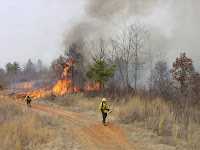April Development of Clearings:
Cleared debris and expanded existing openings by one acre on Perkins GL.
Building Maintenance:
Performed routine depot and site maintenance tasks.
Worked on improvements to depot storage facilities.
Disposed of ½ ton of trash and recyclables.
Boundary Maintenance:
Unposted 1.1, and posted .6 miles of boundary on Three-Top GL.
Posted 2.6 miles of boundary on ALCOA GL in Davie County.
Maintenance of Public Use Facilities:
Mowed and cleaned up around monument site on Hunting Creek Waterfowl refuge.
Road and Trail Maintenance:
Cleared trees and debris from seven miles of administrative roads on TCGL.
Delivered 30 tons of aggregates for road drainage repair project on MRGL.
Cleaned 20 culverts on road system on TCGL.
Maintenance, Repair & Purchase of Non-Highway Equipment:
Performed repairs and maintenance on tractors and other motorized equipment.
Repaired seed drill, disc harrow, sprayer, planter, and other tractor implements.
Firebreaks:
Installed .4 miles of firebreaks on burn areas on Perkins GL.
Herbaceous Planting:
Planted 4.5 acres of firebreaks and other openings on BCGL.
Planted two acres of openings on TCGL.
Sprayed various herbicides on 14 acres of openings on TCGL.
Disked six acres on TCGL.
Tree and Shrub Planting:
Pruned eight apple trees on TCGL.
Vegetation Control:
Bladed and disked ½ acre of early successional openings on Perkins GL.
Planning, Coordination, Evaluation & Reporting:
Routine office work, purchasing, reporting and review of budget.
Miscellaneous State Funded Activities:
Crewmember attended medical appointment relative to workman's comp. injury.
MayBuilding Maintenance:
Performed routine depot and site maintenance tasks.
Disposed of ½ ton of trash and recyclables.
Completed project to waterproof depot storage facilities.
Maintenance of Public Use Facilities:
Cleared vegetation in campground and parking area at Basin Creek on TCGL.
Road and Trail Maintenance:
Spread 30 tons of gravel on MRGL access roads.
Delivered 45 tons of aggregates for road drainage repair project on MRGL.
Closed access road gates on MRGL and TCGL.
Maintenance, Repair & Purchase of Non-Highway Equipment:
Performed repairs and maintenance on tractors and other motorized equipment.
Repaired sprayers, Brillion planter, ATV disk, debris loader, and Huntmaster lift.
Herbaceous Planting:
Spread two tons of fertilizer on dove fields at Perkins GL.
Disked six acres in preparation for planting on TCGL.
Sprayed 7 acres of openings on TCGL.
Planted four acres on TCGL.
Planted ½ acre of field crops on Wilkes Depot property.

Tree and Shrub Planting:
Removed 35 tree shelters from trees and shrubs planted on TCGL.
Released eight mast producing trees from entanglement with kudzu on Perkins GL.
Vegetation Control:
Spot-sprayed for kudzu control in and around 8 acres of openings on Perkins GL.
Planning, Coordination, Evaluation & Reporting:
Routine office work, purchasing, reporting and review of budget.
Waterfowl Banding:
Investigated several wood duck trapping sites, began preparing trapping equipment.
Miscellaneous State Funded Activities:
Assisted herpetologists with survey for bog turtles in Wilkes Depot Bog area.
JuneBuilding Maintenance:
Performed routine depot, yard mowing, and site maintenance tasks.
Disposed of ½ ton of trash and recyclables.
Maintenance of Public Use Facilities:
Mowed 1/2 acre in campground and parking area at Basin Creek, TCGL.
Mowed monument area at Hunting Creek Waterfowl Refuge.
Road and Trail Maintenance:
Spread 45 tons of aggregates for road repair on TCGL.
Blocked illegal ATV access onto TCGL.
Maintenance, Repair & Purchase of Non-Highway Equipment:
Performed repairs and maintenance on tractors, implements, and other equipment.
Prepared Huntmaster lift for use, instructed user, and inspected upon return.
Herbaceous Planting:
Spread 4500 lbs of fertilizer on openings on TCGL.
Spread 7 tons of pulverized limestone on openings on TCGL.
Sprayed 8 acres while planting openings on TCGL.
Planted 11.5 acres on TCGL.
Sprayed and planted one acre on Wilkes Depot property.
Mowed vegetation in 7 acres of openings on TCGL.
Vegetation Control:
Spot-sprayed invasive plants in and around 2 acre Mulberry Mill Bog site.

Planning, Coordination, Evaluation & Reporting:
Routine office work, purchasing, and reporting.
Crew attended regional meeting in Marion.
Waterfowl Banding:
Investigated and prepared several wood duck trapping sites and equipment.
Maintenance, Repair, and Purchase of Highway Vehicles:
Scheduled maintenance of highway vehicles.















































